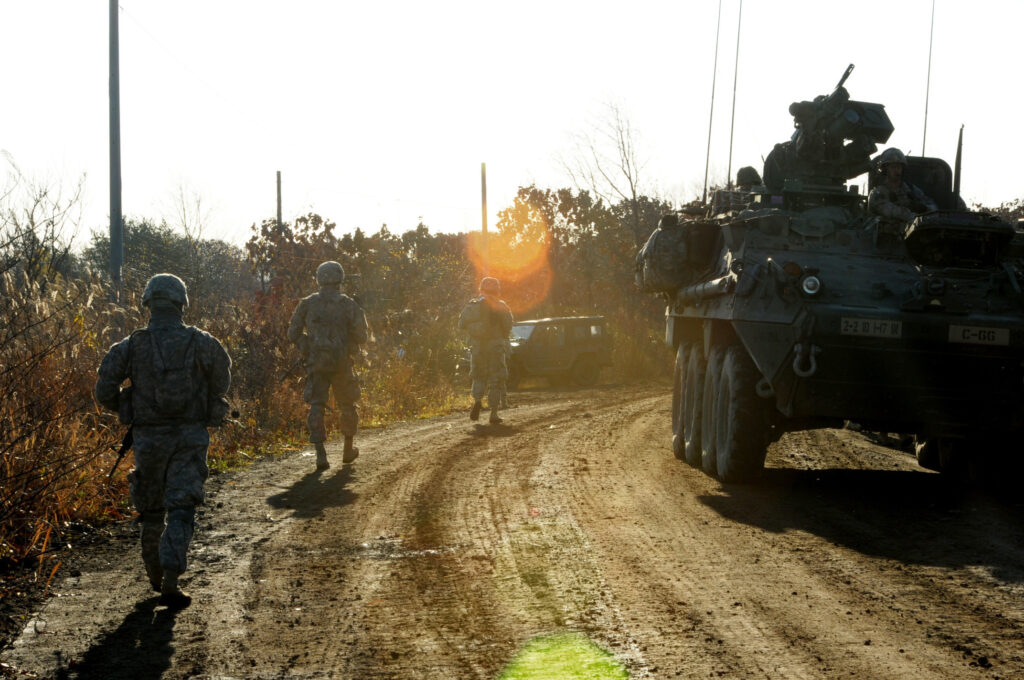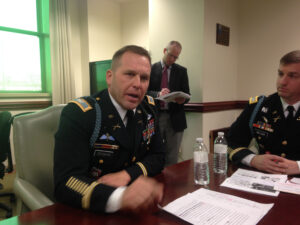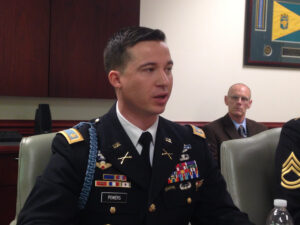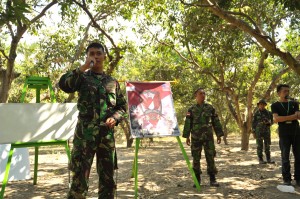Reinventing The Army Via ‘Pacific Pathways’
Posted on

US soldiers exercising in Japan as part of “Pacific Pathways”
PENTAGON: From hunting jungle animals to communicating across the ocean, US Army soldiers learned much in the first Pacific Pathways wargames that Iraq and Afghanistan never taught them. Those exercises are part of the service’s effort to reinvent itself as it shrinks, heading from a wartime peak of 570,000 to 450,000 or below.
Instead of prolonged, large-scale warfare in a single theater, the “complex world” envisioned by the new Army Operating Concept requires smaller forces dispersed across the globe working with friendly nations, especially in Asia, to which US strategy is ostensibly “rebalancing.” (The word “pivot” is now déclassé). Last fall’s exercises with local forces inwere the first-ever Pacific Pathways event. So what is the Army doing differently?
Bottom line up top: It is not spending more money. In an ugly and uncertain budget environment, new spending is not an option, especially for the incredible shrinking Army. Instead, Pacific Pathways repurposes existing funding for longstanding wargames. Last fall’s exercises were annual events that have been going on for years: Garuda Shield in Indonesia, Keris Strike in Malaysia, and Orient Shield in Japan.
One difference with Pacific Pathways, though, is that a single Army unit ran all three exercises. That was the Fort Lewis, Washington-based 2nd Stryker Brigade Combat Team, one of the Army’s regionally aligned units that focuses its training on the culture, geography, and likely crises of a particular region.
By consolidating what had been three disconnected deployments into one operation, brigade commander Col. Louis Zeisman told reporters this morning, “we created some efficiencies,” always a plus in tight budgetary times.

Col. Louis Ziesman (left) and Lt. Col. Shannon Nielsen (right)
What’s more, coordinating operations in four countries simultaneously — from northern Japan to Washington State — gave the 2nd Stryker Brigade’s command, control, and communications systems an unprecedented workout. Rather than keep his headquarters home at Fort Lewis, said Col. Ziesman, “I was allowed to bring all my… command and control systems forward, and we learned a ton of lessons in how we’re going to do distributed mission command.”
“Distributed mission command” is a crucial skill in the new Army Operating Concept, which emphasizes far-flung operations by widely dispersed units using long-range communications and bottom-up initiative. It’s a stark departure from Army traditions of bureaucratic micromanagement. It’s also a departure from the experience of Afghanistan and Iraq, where Army units stayed close to a sophisticated but static infrastructure of bases and networks, with each brigade responsible for its own area.

Maj. Joshua Powers
“In the past we’ve always practiced with these pieces of equipment or employed them in a rather small area,” said Maj. Joshua Powers, who led the brigade’s planning for the exercises. “Here [it] was across the theater. It really load-tests your systems.”
Not all the training was high-tech, however. In Malaysia, a major focus was jungle survival. “They [the Malaysians] taught us were how to trap animals, and the soldiers were blown away by that… A lot of these are city kids,” said Sgt. 1st Class Desmond Politini. “We had never received any time of training remotely like that. As a matter of fact, you won’t get that anywhere you go in the United States.”
“We could probably use better boots,” the sergeant added. “They don’t hold up too well as far as condensation and water in the jungle.”
“No one does jungle field training like the Malaysian army does,” said Poliniti’s battalion commander, Lt. Col. Shannon Nielsen. Overall, “we learned just as much from the Malaysian army as we were able to teach them,” he said, and not just about the jungle. Even in areas where the US had extensive experience, such as counter-insurgency and roadside bombs, said Nielsen, the Malaysians offered a useful new perspective.
Similarly, in the air, Army helicopter crews know how to fly in US-controlled airspace — whether at home or in Afghanistan and Iraq — but dealing with Indonesian air traffic control or Malaysian flight plan filing causes some culture shock. “Those are the kinds of things that you can’t replicate in the United States,” said Capt. Catherine McNair, the brigade’s aviation liaison.
(Ground brigades don’t have their own helicopters, but 11 Apaches and Black Hawks joined the deployment, along with citizen-soldiers from the Army Reserve and National Guard).
Much of the learning was unglamorous. Clearing customs in three different countries’ ports is particularly challenging when you’re shipping military hardware, it turns out. The brigade also had to load and unload its chartered transport ship six times, and by the end they got much better at it. When the troops have to deploy somewhere quickly in a crisis, Zeisman said, these lessons will save valuable time.
The brigade also practiced hard-core combat skills. It did a large-scale live-fire exercise in Indonesia with ground troops, armored vehicles, mortars, and aircraft from both countries operating in close proximity. Then it did an even larger and more demanding wargame in Hokkaido with a Japanese tank division, training to repeal a hypothetical invasion. (No one detailed the scenario, but the historical threat to northern Japan is Russia). At the lower end of the military spectrum, soldiers also performed medical training and disaster response drills.
The physical environment was as varied as the scenarios. The brigade’s big pre-deployment exercise was at the arid National Training Center in the California desert. Then it moved to the humid jungle of Southeast Asia, terrain so dense “you could not even see your hand right in front of you,” Zeisman said. Then it was back to wide open terrain in northern Japan, he said, only about sixty degrees colder.
The soldiers also had to adapt to different cultural and human environments. Even veterans experienced with Afghan elders or Iraqi tribes had to adjust to the very different Asian cultures. Sixty percent of the soldiers had never deployed before at all. “In fact,” said Zeisman, “many of them were in high school just a year prior.”

Indonesian soldiers instruct Americans in jungle warfare.
Senior officers had plenty to learn as well, however, Consolidating the three exercises under one brigade and deploying that brigade’s headquarters allowed for much more high-level interaction. “I was partnered with some very senior officers in Japan, Indonesia, Malaysia and got to build wonderful relationships,” said Zeisman. “Just yesterday I received another email from one of them asking how I was doing.”
“My counterpart was the [Japanese] 7th Division operations officer,” said Maj. Powers. “He was a colonel, I’m a major, so he has substantially more experience than I do, [and] I felt, as I sat next to him and we worked through these scenarios and worked through logistics to support everything, that I was in school. I was taking notes constantly, and I grew as an officer because of that experience.”
This kind of growing experience is “why our soldiers joined the army,” Zeisman said. It’s motivating many to reenlist already, he added to me on his way out of the roundtable: Among the troops that went, he said, “the retention is out of this world.”
Subscribe to our newsletter
Promotions, new products and sales. Directly to your inbox.
